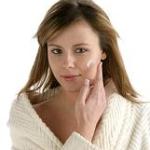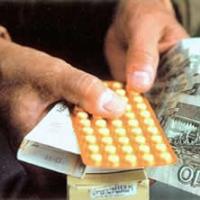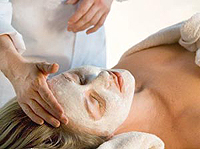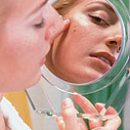How does the light manifest?? What complications of the disease? How to diagnose face? How is the treatment of faces? What is the forecast of the disease? Answers to these questions you will find in the article.
Content
Ryzh is an infectious disease disease.
Patients with burning
Melozic. Women sick burn more often men. More than 60% of cases
Rozhu carry people aged 40 and older. Ryzh is characterized
distinct summer-autumn seasonality.
How does the light manifest?
Incubation
Face period - from several hours to 3-5 days. In patients with S
The recurrent flow of faces of the development of the next attack of the disease
Often preceded supercooling, stress. In the overwhelming majority
Cases The disease begins acutely.
Initial period of faces
characterized by the rapid development of general toxic phenomena that
more than half of the patients for a period of several hours to 1-2 days
ahead of the occurrence of local disease manifestations. Head marked
Pain, general weakness, chills, muscular pain. 25-30% of patients appear
nausea and vomiting. Already in the first hours of the disease, the temperature rises to
38-40°WITH. In areas of skin in the field of future manifestations in a number of patients
A feeling of cutting or burning, weak pain appear.
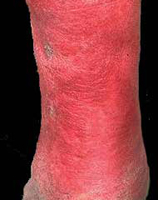
Wagon
Rise disease occurs in time from several hours to 1-2 days
after the first manifestations of the disease. Reach their maximum
General toxic manifestations and fever. There are characteristic local
manifestations of faces. Most often, the face is localized on the lower limbs,
less often on the face and upper limbs, very rarely only on the body, in
Areas of the breast, crotch, outdoor genital organs.
At first
A small red or pink spot appears on the skin, which
The course of several hours turns into a characteristic corrosive
redness. Redness is a clearly delimited area
Skin with uneven borders in the form of teeth, «Languages». Leather in the area
redness is tense, hot to the touch, moderately painful when
feeling. In some cases, you can detect «Regional roller» as
Raw edges of redness. Along with the redness of the skin develops
her swelling extending from redness.
Development
Bubbles is associated with increased effusion in the focus of inflammation. At
damage to bubbles or their spontaneous break occurs
The expiration of the fluid on the site of bubbles there are surface wounds. At
Conservation of the integrity of bubbles, they gradually sneeze with education
yellow or brown crust.
To residual pensions,
Pastened for several weeks and months
Eyefoot and skin pigmentation, dense dry crusts on the site of bubbles.
What complications of faces
Complications of faces, mostly local
character, observed in a small number of patients. To local
Father's complications include abscesses, phlegmon, leather sacrifice, suppuration
bubbles, inflammation of veins, thrombophlebitis, inflammation of lymphatic
Vessels. Common complications developing in patients with illness
rarely include sepsis, toxic-infectious shock, acute
Cardiovascular insufficiency, pulmonary artery thromboembolism and
Dr. The consequences of the faces include persistent stagnation of lymphs. According to modern
representations, stagnation of lymphs in most cases developing in patients
Rogging against the background of already available functional failure
leather lymphorage (congenital, post-traumatic and other.).
How to diagnose face
The diagnosis of faces is carried out by a physician or info.
- Detection
Streptococca in the blood of patients (using PCR (polymerase chain reaction)) - Inflammatory changes in general blood test
The diagnostic criteria of faces in typical cases are:
- A keen beginning of the disease with pronounced symptoms of intoxication, an increase in body temperature up to 38-39°C and higher;
- The preferential localization of the local inflammatory process on the lower limbs and face;
- development of typical local manifestations with characteristic redness;
- an increase in lymph nodes in the inflammation area;
- lack of pronounced pain in the focus of inflammation alone
How is the treatment of faces
Treatment of faces should be carried out taking into account the form of the disease, nature
lesions, availability of complications and consequences. Currently
Most patients with mild rodies and many patients with
The medium-eyed form of the face is treated under polyclinic conditions.
Indications
For mandatory hospitalization in infectious hospitals (branches)
are:
- severe course of faces;
- frequent relapses of faces;
- the presence of severe common concomitant diseases;
- Old or children's age.
The most important
The place in the complex treatment of illness occupies antimicrobial
therapy. In the treatment of patients under polyclinic and house
It is advisable to appoint antibiotics in tablets: erythromycin,
Eletetrin, Doxycycline, Spiramycin (course of treatment for 7-10 days);
azithromycin; Ciprofloxacin (5-7 days); Rifampicin (7-10 days). At
Antibiotics intolerance are shown by Furazolidon (10 days); Delady
(10 days). Treatment of faces in the hospital conditions it is advisable to conduct
benzylpenicillin, course 7-10 days. With severe disease,
Development of complications (abscess, phlegmon, etc.) Combination is possible
benzylpenicillin and gentamicin, destination cephalosporins.
With pronounced inflammation of the skin, anti-inflammatory drugs are shown: chlotazol or butadion for 10-15 days.

Patient
Rating is required to appoint a complex of vitamins for 2-4 weeks. At
The serious flow of faces is carried out intravenous disintellation
Therapy (hemodez, Reopolyglyukin, 5% glucose solution, physiological
Solution) with the addition of 5-10 ml of 5% solution of ascorbic acid,
Prednisolone. Cardiovascular, diuretic are prescribed,
Antipyretic means.
Treatment of patients recurring. Treatment of recurrent faces should be carried out in hospital.
Be sure to assign backup antibiotics that did not apply when
Treatment of previous relapses. Cefalosporins are prescribed intramuscia
or Lincomycin intramuscularly, rifampicin intramuscularly. Well
Antibacterial therapy - 8-10 days. With especially stubborn relapses of faces
Advisory twocurrent treatment. Consistently appointed
Antibiotics, optimally acting on Streptococcus. First grade
Antibiotic therapy is carried out by cephalosporins (7-8 days). After
The 5-7-day break is conducted by the second course of treatment with Lincomicin (6-7
days). With recurrent feeling, immunity correction is shown
(methyluracil, nucleicate sodium, Prodigiosan, T-activin).
Local therapy of faces. Treatment of local manifestations of faces is carried out only with its bubble forms
with the localization of the process on the limbs. Erythematous form of faces not
requires the use of local treatments, and many of them (ichthiolic
ointment, balsam Vishnevsky, ointment with antibiotics)
contraindicated. In the acute period of faces in the presence of intact
bubbles are carefully cautious from one of the edges and after the exit
Liquid on the focus of inflammation impose a bandage with 0.1% solution
Ranavola or 0.02% solution of furaticiline, changing them several times in
The course of the day. Tight binting is unacceptable. With extensive
Washing wound surfaces on the spot shoved bubbles local
Treatment of faces begin with manganese baths for limbs followed
imposing listed above bandages. For treating bleeding
Applied 5-10% Dibunol Liniment in the form of applications in the field of the hearth
Inflammation 2 times a day for 5-7 days.
Traditionally B
The acute period of the faces is appointed ultraviolet irradiation to the area
The focus of inflammation, on the region of lymph nodes. Appliques are prescribed
ozokerite or dressings with heated naphtalan ointment (on the bottom
limbs), paraffin applications (on the face), electrophoresis of lidase,
Calcium chloride, radon bath. High efficiency is shown
Low-intensity Laserrapy Local Flood Inflammation. Used
The dose of laser radiation varies depending on the state of the focus,
The presence of concomitant diseases.
Prevention and forecast of faces
The prevention of peers recurrences is an integrated part of the complex
Dispensary treatment of patients suffering from a recurrent form
Diseases. Preventive intramuscular introduction of bicillin (5-1.5
million units) or retarpen (2.4 million units) prevents recurrences of the disease,
Reinfection of Streptococcus.
With frequent recurrences
(not less than 3 over the past year) Faces are permanent
(year-round) bicyllinoprophylaxis for 2-3 years with
Interval of the introduction of Bicyllin 3-4 weeks (in the first months the interval
can be reduced to 2 weeks). In seasonal relapses, the drug
begin to enter a month before the end of the incidence of this
Patient with an interval of 4 weeks for 3-4 months
annually. With significant residual phenomena after
The faithful bicyllin faces are introduced with an interval of 4 weeks throughout
4-6 months.
- With adequate treatment of lungs and medigative forms - complete recovery.
- Chronic lymphatic edema (elephantity) or scars in chronic recurrent flow.
- Elderly and weakened - high frequency of complications and inclination to frequent recurrence.



